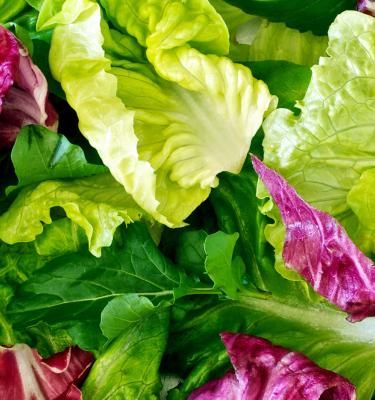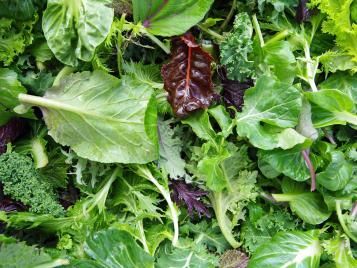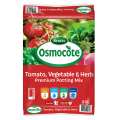

How To Grow Salad Leaves
Bags of salad leaves are quite expensive to buy and have a fairly short lifespan in the fridge. Grow your own salad leaves and you can pick exactly how much you need on a daily basis. By growing a range of different types and sowing at different times of year, you can have fresh salad leaves available nearly all year round. Many salads leaves are grown as 'cut and-come-again' crops, which you can harvest over a long time.
Salad leaf varieties
There are lots of different salad leaves available. Here are some of the best and most popular salad leaves available to grow in Australia. Many seed suppliers sell them as salad leaf mixes of blends of different types, colours and flavours.
- Chinese cabbage: Often sold as Chinese leaves, it is fast growing and can be ready for cutting in as little as 6 weeks.
- Corn salad or lamb’s lettuce: Hardy, making it the perfect choice for winter and early spring salads. It forms small rosettes of bright green, succulent leaves.
- Endive: Usually blanched to reduce its bitter content.
- Watercress: Ready to eat in 7-8 weeks.
- Rocket: An easy to grow, fast-maturing salad. Late summer sowings will continue cropping into the winter if the plants are grown indoors or in a sheltered spot.
- Winter purslane: An attractive winter salad also known as claytonia or miner's lettuce.
- Oriental vegetables: There are numerous ways of using these, from adding to salads, stews and soup, for stir-fries and as a lightly steamed vegetable. They include Chinese mustard greens, bok choy, pak choy. Japanese mustard spinach (komatsuna), mibuna and mizuna.

What you’ll need to start growing salad leaves
Get your salad leaves off to a good start with these growing essentials:
- Garden fork and spade
- Trowel
- Compost or soil improver
- Vegetable fertiliser
- Salad leaves seeds
For container sowing:
- A suitable container, such as a window box or pot
- Vegetable and herb potting mix or seed raising mix
- All Purpose liquid plant food
How to grow salad leaves
Cultivation
Most salad leaves prefer an open, sunny position, although they will tolerate light shade. During hot, sunny summers, they may do better in a shaded spot to protect them from wilting.
Before sowing, improve the soil with some soil improver or compost to improve water holding and add a dressing of a slow release vegetable and herb plant food.
Most salad leaves can also be grown in small pots, window boxes, grow-bags or planters. Grow some in containers on the windowsill to have them ready at your fingertips - and times when it may be too cold outside.
Sowing salad leaves
Sow in short rows every fortnight or so, enough for your needs, to have a continuous crop. Sow seeds thinly about 1cm deep, cover with soil and water in well.
How to care for salad leaves
Keep the soil moist at all times, but without overwatering. If the soil dries out the plants may bolt (go to seed prematurely) and lose their strong flavours.
If necessary, thin out seedlings when they're about 2.5cm high. The thinnings can be used in the kitchen as micro greens.
To encourage fast growth that is tender and full of flavour, feed plants every 3 weeks with an All Purpose liquid fertiliser.
Harvesting salad leaves
Harvest leaves as and when they are needed once the plants are about 7.5-10cm high. You can either pick individual leaves from the outside of the plants or harvest over the whole plant using scissors.
It is best to cut in the morning, when the plants will be at their freshest.
Common salad leaves pests diseases
| Grey mould / Bortrytis mould |
Grey mould is a fungal disease that appears as pale discoloured patches on salad leaves, turning to a grey fuzzy growth. It is more common in wet weather.
|
|---|---|
| Slugs and snails |
Slugs and snails feed on young lettuce seedlings, and can be identified by the slime trails that they leave, as well as the damage they do.
|
FAQs
How to grow salad leaves indoors?
To grow salad leaves indoors, choose a bright spot with at least 4-6 hours of direct sunlight or use grow lights. Use well-draining soil in shallow containers or trays. Keep the soil consistently moist but not waterlogged. Salad greens like lettuce, spinach, and rocket thrive at 15-20°C, though some varieties tolerate slightly cooler or warmer conditions. Harvest leaves regularly to promote continuous growth.
How to grow salad leaves in pots?
To grow salad leaves in pots, select a container with good drainage and fill it with quality potting mix. Plant seeds of lettuce, spinach, or other salad greens, spacing them roughly 5-10 cm apart. Place the pot in a sunny location with at least 4-6 hours of light daily. Keep the soil moist and harvest the salad leaves regularly for fresh, delicious salads.



